Photo
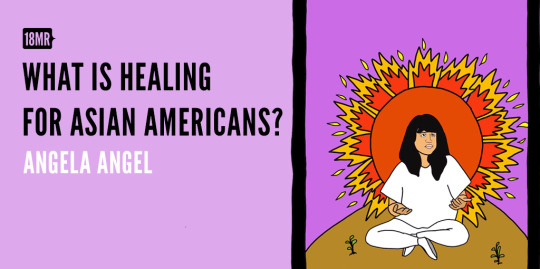
Join us as we slow the fuck down with Angela Angel (and her plants!) in our 3rd interview in the “What Is Healing for Asian Americans?” series:
sumi: You are a gardener, artist, medium, and ceremonialist. As a young traditional healing practitioner, your work is a continuation of your indigenous lineage– the Bontoc and Ibaloi tribes (the Igorot) of the Philippines. What does living out your purpose and traditional healing practices look like in Oakland, CA (your current home)?
Angela: Aside from when I’m with students or clients, I spend most of my time interacting with the plants, the earth, and my ancestors. I’m really talking to them and returning back to my ancestors’ ways of animism.
I spend my time cultivating my relationship back to our earth, because we have broken lines. This isn’t this glamorous thing. I’m in a big process of decolonization and a big part of my spirituality is decolonization. What that looks like is diving deep into ancestral work. I spend a lot of time sitting at my altar and working there. Making medicine and being in the garden. This requires a lot of spaciousness – to slow down and connect with the earth.
Unfortunately, this process of rematriation sometimes feels like a privilege to me because most of my friends, family, and the public are very much in the grind. When I’m in my home and garden space, I feel like I’m just playing. Which is beautiful to me, but if you contrast it with most of the world, it feels like a privilege. But that’s the only way at this point.
sumi: What is a medium?
Angela: A translator of languages, frequencies, vibrations, colors. An empath, but in a way that we are able to control that sensitivity and use it to support clarity and healing for others. A deep connection with the earth and the elements. An avatar, being in tune so deeply and authentically that you’re able to work with the elements around you.

sumi: The dominant Western worldview does a tremendous job of separating us [humans] from nature. Similarly, trusting your psychic visions in a culture which doesn’t honor your feelings and sensations as real information, is no small thing. How did you learn to trust your visions and the land?
Angela: That’s pretty much what it means to be Indigenous– to have full trust and deep connection with the earth. It’s our way of life.
I feel hopeful because we are in a time of decolonization. Our dominant culture doesn’t allow for us to trust in the earth and in things that are unseen. Religion, colonialism, internalized colonialism, and capitalism have all violently impressed upon us not to trust in our Mother, Our Earth. When you’re severed from the earth, you completely forget her. We’ve been in that great forgetting for a while now.
For me, I feel blessed that I was raised that way. Next to the earth, my mama was my first teacher and I learned to take care of the land from her. Nature is what should feel natural because it’s our inheritance and it’s our inherent-ness. As human beings, we have a long way to go with rebuilding that trust.
sumi: For folks who didn’t grow up with someone who taught us this value of trusting earth, or seeing the earth as our mother – where’s a place to start?
Angela: I think it’s both subtle and also a product of assimilation that people didn’t grow up with that direct connection. For the most part, it’s always been there.
THE SUBTLETY COMES FROM ESTABLISHING A RELATIONSHIP TO NATURE, THE SAME WAY YOU WOULD ESTABLISH A RELATIONSHIP WITH A NEW FRIEND.
You pay attention, you make acknowledgements, you give them a gift, you listen to them, you respect them, you establish consent, you make a meal for them, you tell them you love them.
All of that is the same when you are working with the plants: you observe, you become quiet, you become still, you pay attention to the way they grow, you offer them water, you ask permission to take from them, you also greet them, and tell them you love them. The same reverence we give to our human loved ones is the same reverence I carry with the earth.
sumi: Healing historical and ancestral trauma is central to your work as a practitioner. Why is this so important? And are ancestors more than just our blood family?
Angela: Yes. We are connected to so much rich history that is within our blood lineage, but if you go further back, we are connected to so much more. We’re connected to the animals, the plants, and to what is known as the unseen. There’s multiple worlds that we’re connected to that I would consider our ancestors.
We’ve been on this planet as a peoples and as our lineages for a very long time. When people describe themselves as an old soul, I sometimes laugh at that. At this point, everybody is an old soul! If you look at it generationally and spiritually, we have our grandmothers that are being reborn into this planet. We’re very, very old. We’ve accumulated thousands of years of trauma and repeating history in a cyclical, destructive way.
ONCE YOU’VE GOTTEN TO A CERTAIN LEVEL OF YOUR HEALING WORK, YOU’LL HIT A TENSION THAT EITHER YOU NEED TO CONFRONT, OR IT’S GONNA CONTINUE AS THIS PATTERN IN DIFFERENT WAYS. THAT IS ANCESTRAL WORK.
In order to change our world, we have to get into the deep inner work, coupled with all the other things which we may already be doing, like organizing and taking care of our daily needs. It’s vital to our systems, especially in our partnerships and families.
[Often] we get so enthusiastic and ready to change the world in this very external way. It’s what I would describe as hypermasculine. I definitely think this needs to continue happening and it has its role. But if we’re having all this turmoil in ourselves and families and we just keep running away from that – either because it’s too hard or we don’t wanna deal with it – that extends into the rest of our work. We can’t just change things from the outside in, we need to do it both ways.
sumi: What does ceremony mean to you?
Angela: I would describe my life as ceremony. That’s how our ancestors lived and continue to do so.
CEREMONY IS A LIFESTYLE. NOT LIKE, “I’M GONNA DO YOGA BECAUSE IT’S TRENDING,” BUT A LIFESTYLE WHERE YOU HAVE TO WALK IN SUCH A WAY WHERE YOU ARE REALLY IN TUNE AND PAYING ATTENTION TO THINGS.
It’s a mothering way of being. For me, ceremony could be as small as daily rituals like waking up in the morning and stretching, or it could be much more formal and intentional.
To talk about ceremony is to talk about why we even need it. It’s at a level where language feels very limiting. It’s a way of us mirroring the natural order of the universe. When we mirror that, we become in tune with the sacredness of all and the natural cycles of things.
Ritual is a way of continuously birthing yourself into existence. Specifically, rites of passage rituals are so important. We barely have that today, perhaps only in the form of weddings or giving birth.
In our ancestors’ time, people were initiated often. For example, when a child is stepping into a certain level of their maturity or when you’re becoming an elder. We honor different stages of life and death.
We used to have these rituals to understand our role as members of our community. What we’re seeing now is when we’re not formally initiated, we get initiated a different way. Either it becomes a disaster, we become ungrounded from it all, or we find our way. For example, when there’s a shocking death in the family. If people don’t honor it, if they don’t create a ceremony around it, the soul and the family becomes lost.
When we do ceremonies, we’re creating space for people to come into themselves and into the reality that their loved one has now graduated from life. We’ve lost a lot of that, or we have diluted versions of it which are based on pressures to look and be a certain way– like weddings.

sumi: What is the gift of an imperfect ancestor?
Angela: It means working with all the different lines within us. We have a history that is violent and full of terror and trauma and that exists within us.
WE HAVE ANCESTORS THAT ARE OUR COLONIZERS. BUT IT IS ALSO A GIFT BECAUSE WE DON’T WANT THAT TO CONTINUE.
By doing ancestral work we’re able to see our imperfect ancestors through compassion, through their original innocence.
sumi: What do plants want us to know?
Angela: To learn their song.
62 notes
·
View notes
Photo

Letters for Black Lives is a set of crowdsourced, multilingual, and culturally-aware resources aimed at creating a space for open and honest conversations about racial justice, police violence, and anti-Blackness in our families and communities.
An amazing team of more than 330 volunteer translators just dropped 26 translated letters in support of #BlackLivesMatter! Use these letters to talk to your family and community about why we must support #BlackLivesMatter. Get the letters here and stay tuned for more translations to come!
"Since the first letter in 2016, we’ve had four years of increased racism within the US and another rise of white supremacy around the world. So this year, the community wrote another letter — because we are sad and angry, but also because we are full of love for our families and have hope for a more just and equitable future.”
The first set of 2020 letters includes:
Albanian, Armenian (Eastern), Bangla, Bosnian, Burmese, Chinese (Simplified), Chinese (Traditional), Croatian, English, Farsi, French, German, Greek, Hmong, Indonesian, Japanese, Khmer, Korean, Lao, Nepali, Polish, Portuguese (Brazilian), Spanish, Sylheti, Tagalog, and Turkish.
#black lives matter#george floyd#asian american#asians for black lives#police brutality#letters for black lives
63 notes
·
View notes
Photo

In the midst of powerful uprisings in defense of Black lives, the time to practice solidarity is now. One way we can act today to stop killing Black people is to stop calling the police, and to make sure our loved ones stop too. We know this may be a difficult conversation and there is no one right way to do it. But, as Asian Americans committed to justice, we must try. Black lives depend on it.
We wrote a letter to help you talk to your own family about not calling the police.
As Asian Americans, we are demanding that our community take control of how we interact with the police and work to redefine what safety looks like, in solidarity with Black communities. We must stop investing in a police system that is violent and racist.
TRANSLATIONS NOTE: We are working on multiple Asian language translations of this letter in partnership with Equality Labs. Stay tuned for announcements about these translations! Want to help translate? Send us a message at [email protected]
45 notes
·
View notes
Photo

We’re super excited to share our new shirts with you, created in partnership with Asian Prisoner Support Committee!
We need your support to reunite four Cambodian deportees with their families and community. If we’re able to stop people from getting deported, we can also bring them back home!
We’re raising $3,000 to pay for Kay Kay, China, Tone and Chantha’s legal defense. 100% of shirt proceeds go to APSC, who are working to reunite them!
Kay Kay, China, Tone, and Chantha came to the US as refugee children fleeing from the US-backed genocide in Cambodia, the Khmer Rouge. Now, ICE has ripped apart their families because their status as formerly-incarcerated refugees made them targets for deportation.
Kay Kay, China, Tone and Chantha’s families were resettled by the US government in heavily-policed and under-resourced neighborhoods in California. As youths in the 1990s, they committed crimes during an era of “tough on crime” laws that drove mass incarceration to new heights.
Kay Kay, China, Tone and Chantha rebuilt their lives after being released. Now they are struggling to survive after being deported to Cambodia, a country they do not know. 80% of all deportation orders for Southeast Asian Americans are based on old criminal records that have already been served.
These Cambodian refugees escaped one of the worst genocides of the 20th century to seek safety in the US, only to be deported and separated from their families.
Get a shirt to help reunite Kay Kay, China, Tone and Chantha’s families!

🎨 Our shirt design is by Raychelle Duazo, a queer femme Filipina-American illustrator and tattoo artist from the Pacific Northwest. See more of Raychelle’s work @bombchelle.
32 notes
·
View notes
Photo

No one belongs in a cage. This year, in honor of Yuri Kochiyama and Malcolm X’s joint birthday on May 19, we’re raising $1,000 for a bail fund. $1000 is the amount it takes to free one incarcerated Muslim who is currently locked up in a jail or ICE detention center.
This fundraiser is in partnership with Believers Bail Out, a Chicago-based national effort to bail out Muslims who are being held in jail prior to their right to a trial, or trapped in ICE custody. BBO is community-led and volunteer-run, predominantly by women of color. In the past two years, BBO has freed 38 Muslims from jails and immigration incarceration by paying their bail!
Help us free people from cages! Support our bail fund here.
26 notes
·
View notes
Photo

Order our UNMASKING YELLOW PERIL zine and all funds will go to CCED’s mutual aid work in Chinatown Los Angeles and beyond! CCED is supplying hundreds of hot meals and care packages with groceries and cleaning supplies to elders and community members in critical need.
Unmasking Yellow Peril is a colorful zine full of archival images, forgotten histories, and critical analysis about Yellow Peril. With this project, we seek to ground ourselves in the long history of Yellow Peril, uncover its main forms, and resist it in the time of COVID-19.
Order your zine here! Or, you can read Unmasking Yellow Peril online here.
CCED is an all volunteer, multi-ethnic, intergenerational organization based in Los Angeles Chinatown that builds grassroots power through organizing, education, and mutual help. Learn more and sign up to volunteer at ccedla.org!


Unmasking Yellow Peril was created in collaboration with the Asian & Asian American Studies Institute at the University of Connecticut, and Jason Oliver Chang, Associate Professor of History and Asian American Studies at the University of Connecticut.
Zine art + design by Bianca Nozaki-Nasser, photos from CCED
#apahm#yellow peril#mutual aid#chinatown#los angeles#chinese american#covid 19#xenophobia#racial justice
50 notes
·
View notes
Photo
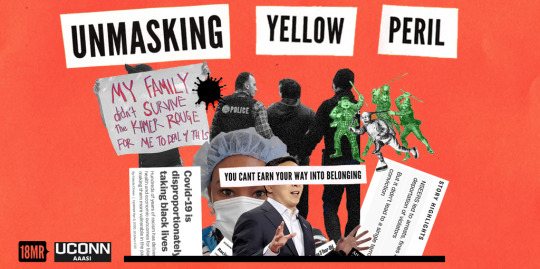
Not only do Asian Americans worry about surviving the virus, we also fear for our lives. Our loved ones are experiencing skyrocketing levels of unchecked hate and violence – over 100 hundred hate crimes a day. This violence is the latest iteration of Yellow Peril. It is a form of white supremacist settler nationalism that the U.S. pioneered to peddle racial fear and justify endless global war and the exploitation and expulsion of what they perceive as diseased and enemy Asians.
What we are experiencing in 2020 is tied to the violence of the mid-1800s when Chinese immigrants were targeted while risking their lives to lay railroad tracks. As a result of white suspicion and fear, the US passed racial bans on immigration and naturalization in the Chinese Exclusion Act of 1882. This law created a new gold standard in settler states and made Yellow Peril a core element of US national identity.
The onset of the COVID-19 pandemic fit the ready-made story of Yellow Peril in the US. Racist responses to the spread of the disease are consistent with a history of treating Asians as a foreign threat. Part of undoing the power of Yellow Peril is confronting the history of empire, capitalism, and white supremacy and building a vision of peace, justice, and health which celebrates and honors our interdependence.

Unmasking Yellow Peril is a collaboration between 18 Million Rising, the Asian and Asian American Studies Institute at UConn, and Jason Oliver Chang, Associate Professor of History and Asian American Studies at UConn. We seek to ground ourselves in the long history of Yellow Peril, uncover its many forms, and resist it in the time of COVID-19.
Yellow Peril has been here for more than a century, it’s time to unmask it.
Learn more about the history of Yellow Peril and download our free Unmasking Yellow Peril zine!
#yellow peril#asian american#us history#apahm#asian american history#racial justice#immigrant rights#covid-19#anti asian racism
222 notes
·
View notes
Photo
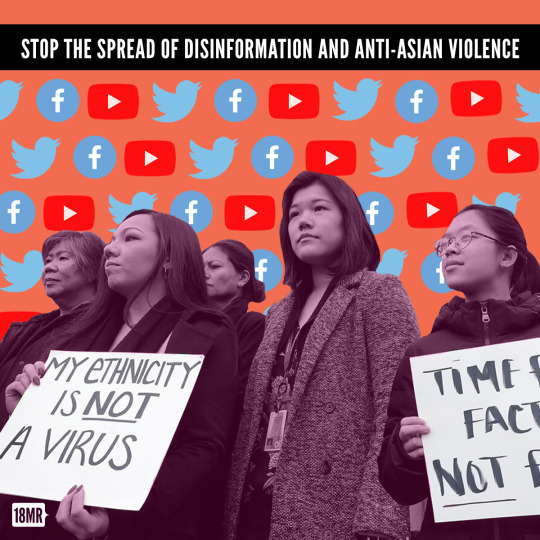
During the pandemic, anti-Asian hate and COVID-19 disinformation are putting lives at risk. Coronavirus opportunists are using the internet to spread their dangerous lies and fuel xenophobic and racist violence.
Asian Americans are being blamed for spreading COVID-19, particularly those of us who are of East Asian descent. Asian Americans are now experiencing over 100 hate crimes per day related to the virus.
Millions of people are sheltering in place and dependent on social media for up-to-date, truthful information about how to keep themselves safe. It’s urgent that social media companies crack down on the hate and disinformation spreading across their platforms.
Tell Facebook, Twitter and YouTube to immediately shut down hate and misinformation about COVID-19 on their platforms.
47 notes
·
View notes
Photo

You're invited to ANTIDOTES 4 YELLOW PERIL! From Filipino nurses on the COVID-19 frontlines, to Chinatown businesses closing due to xenophobia, Asian Americans are challenged to heal and be the freedom fighters our communities need right now. That’s why we’re teaming up with Spenta Kandawalla of Jaadu Acupuncture and co-founder of generative somatics to bring you a virtual healing practice space, in the time of pandemic and Yellow Peril.
The event, on April 25 at 1 pm ET, is FREE with sliding scale donations and open to all. Register here.
Participants will be guided through somatic practices and learn how Traditional Chinese Medicine can build our resilience and immunity.
Accessibility:
✿ We will have ASL interpretation for the event.
✿ The practitioner will share adaptations to each somatic practice to meet participants’ diverse physical needs.
✿ Participants who register will have unlimited replay access to the event, even if they do not attend it live.
✿ Unfortunately, we are unable to provide live closed captioning.
#asian american#healing justice#covid-19#yellow peril#anti-asian racism#chinese medicine#somatics#racial justice#immigrant rights#chinese american
18 notes
·
View notes
Photo

Here's some Black and Filipino solidarity worth celebrating!
Born in the 1870s, David Fagen was an African American soldier who was deployed to Manila during the Philippine-American War. Soldiers, and the greater US public, were told that Filipinos were racially inferior and needed to be civilized. Fagen's job was to battle Filipino resistance and bring democracy to the country.
But after arriving in the Philippines, Fagen saw how Filipinos faced racism and brutality from white US soldiers. Having endured racism in the US South and in the Army, Fagen began to identify with the very people he was sent to fight.
In 1899, Fagen defected and joined the Filipino Liberation Army. He quickly rose in ranks to become a guerrilla leader and traitor to US imperialism. His actions inspired other Black soldiers to defect, and drove the Army on a wild hunt to capture him.

This second image is an 1899 cartoon titled "Not in Position to Give Up the Chase", by cartoonist Clifford Berryman. It shows Uncle Sam chasing after the Philippines to subdue it.
472 notes
·
View notes
Photo

Asian American Valentines (or how we say “I love you”): Taking your shoes off in the house. Washing the rice properly. Bailing our fam out of detention. WhatsApp text threads. Cut fruit. Loving our melanin.
Sign up for our monthly newsletter, “Did You Eat Yet?” and we’ll send some radical love to your inbox this season.
48 notes
·
View notes
Photo

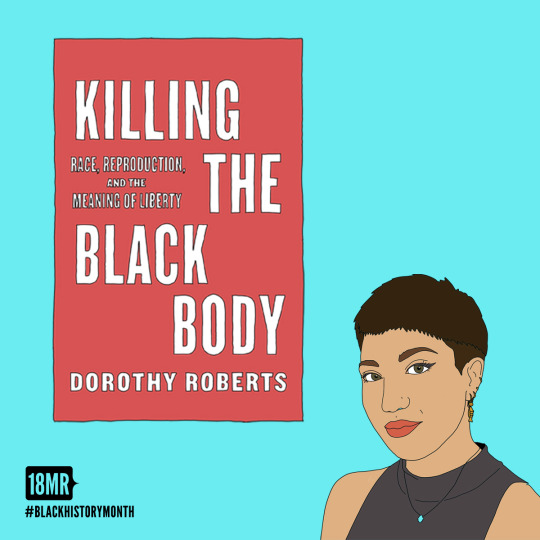
What are you reading this Black History Month? Here are 2 books from 18MR's BLACK HISTORY MONTH READING LIST FOR ASIAN AMERICANS:
Taz says Bengali Harlem documents a time in history when "..Bengali Muslims were sneaking into the country by jumping off ships and into America’s most iconic neighborhoods of color, from Tremé in New Orleans to Detroit’s Black Bottom, from West Baltimore to Harlem."
Bianca on Killing the Black Body - "Even though this was first published in 1997, two decades later it is still a relevant and critical text in understanding America’s systemic abuse of Black Women’s bodies and the exclusion of Black women’s reproductive needs in mainstream feminist and civil rights agendas."
Illustrations by Bianca Nozaki-Nasser
#black history month#black authors#south asian#Harlem#bengali#reproductive justice#black lives matter#asian american
28 notes
·
View notes
Photo

We're celebrating Margo Okazawa Rey this Black History Month! Margo was a founding member of the influential Black feminist organization, Combahee River Collective.
Created in 1974, the Combahee River Collective was instrumental in calling out "interlocking oppressions" - a way to name how sexism, racism, homophobia, and capitalism together impacted Black women's lives. Collective members resisted racism in the mainstream feminist movement as well as sexism in Black liberation movements. Their work helped pave the way for future social justice activism, including Black Lives Matter.
Read Combahee River Collective’s statement here.

Margo is among the first generation of mixed race children born to a Japanese mother and an African American soldier. This experience has influenced her to fight militarism - in East Asia, Guam, Palestine, and beyond - as a scholar and activist. Thank you for your incredible work and contributions, Margo!

#black history month#black history#black feminism#combahee river collective#margo okazawa rey#japanese american#mixed race#qtpoc#intersectionality
597 notes
·
View notes
Photo

Happy Black History Month! Our work in the Asian American movement would not be possible without the Civil Rights and Black Power movements, the Third World Liberation Front, the fight for ethnic studies, Black Lives Matter and more.
To honor this legacy, 18MR has teamed up with Asha Grant, founder of The Free Black Women’s Library - Los Angeles, to share some of our favorite Black History Month reads.
Asha has 2 special recommendations to share! Learn more about The Contested Murder of Latasha Harlins: Justice, Gender, and the Origins of the LA Riots and Sister Outsider in OUR BLACK HISTORY MONTH READING LIST FOR ASIAN AMERICANS.
#black history month#black authors#audre lorde#latasha harlins#la riots#asians for black lives#asian american
101 notes
·
View notes
Photo

How’s your 2020 going, Tumblr? In a perfect world, your year is going great; Your skin is clear, you’re getting a full eight hours of sleep, you’re not at risk of feeling the effects of voter suppression, climate change is nothing to worry about, and your reproductive rights are never challenged.
But this isn’t a perfect world. Over the past 12 months, people with power have carefully interpreted laws to throw citizens off of voting rolls, we’ve become more aware of how desperately we need to save our planet, and reproductive rights are a constant battle around the world. This year, we’re committed to bringing important discussions on issues like these to your dashboard.
We’re calling it #Issues2020.
It’s not too late to make a change. That’s the crux of #Issues2020. The power is in your hands. Whether you’re gearing up for the U.S. presidential election, in the UK organizing in your community, engaging with the French Senate elections, following the South Korea legislative elections, or participating in any of the many, many elections happening around the globe this year, it’s never too late for civic engagement in your community. At the local, national, and global levels, there are ways to make a difference. You can call your political leaders to support or oppose an issue, endorse a candidate, organize a rally, lead a respectful discussion with your friends, volunteer to phone bank, and so much more.
We want to give you a space to learn from others while teaching them, too. You can be a valuable resource. To help that along, we’re partnering with six powerful organizations to hold Q&A sessions here on Tumblr.
They’re called Issue Times, and they’ll be held throughout the year:
February - Voting rights with Black Girls Vote (@blackgirlsvote)
April - Mass incarceration and immigration with 18 Million Rising (@18MR)
June - Reproductive rights with Planned Parenthood Action Fund (@ppaction)
July - Gun reform with TBD
August - Climate change with TBD
October- youth Activism with(@itgetsbetterproject)
In addition to our upcoming Issue Times, we’re partnering with other organizations that keep people informed on things that matter. When We All Vote (@whenweallvote) will provide you with resources on registering to vote right on your dashboard if you go follow ‘em.
These organizations are here to help foster discussion, teach all of us how to be better citizens and neighbors, and outline what we’re up against. To make sure you get a chance to ask them your question, follow their Tumblrs as well us here on @action.
This isn’t a perfect world, but we can make improvements. It’s up to all of us. If you’re allowed a voice to safely use, use it. If you can vote, vote. Do it for yourself, for your loved ones, and for the people around you who may not be able to vote themselves.
What kind of commitment can you make this year for your community, Tumblr? What issues are you fighting for? Let us know in a post. Tag it #Issues2020 so other people can easily find it to hear your story and feel a little inspiration. https://mail.google.com/mail/u/0/#inbox/LXphbWZLdPFTtqvKwWvlRPvxcHKPqtvffkKfdMmrkSq
6K notes
·
View notes
Text
Asians for Black Lives

Happy Lunar New Year! We're thrilled to announce that we're partnering with The Free Black Women’s Library - Los Angeles and founder Asha Grant to relaunch our Asians for Black Lives shirts! This limited-run Yuri Kochiyama and Malcolm X design was created by Natalie P Bui, an LA-based Vietnamese American illustrator. The design reflects the radical legacy we see ourselves in -- one in which Asian Americans are in deep solidarity with Black communities.
During Lunar New Year and Black History Month, we will be donating 50% of all proceeds from the sales of our Yuri and Malcolm X design to support The Free Black Women’s Library of Los Angeles.
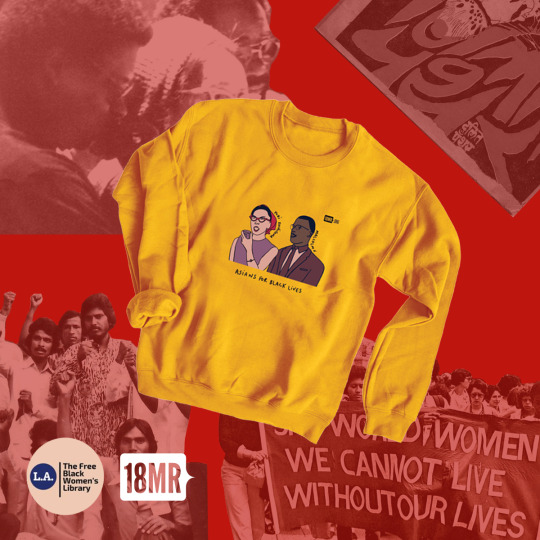
📕 Learn more about The Free Black Women’s Library - LA and get a Yuri and Malcolm shirt 📕
The Free Black Women’s Library was birthed by OlaRonke Akinmowo in the summer of 2015 in Brooklyn, NY to celebrate Black women writers, artists, and creatives through community trading.
The Free Black Women’s Library - Los Angeles is a new sister-site established in January 2019. They are a grassroots traveling book exchange and free literary event series that centers Black women writers, with events ranging from art-making workshops to book discussions and screenings. Their vision is to unite and build brave anti-racist, anti-sexist communities across LA who are committed to love, liberation, and literacy for all.
#black lives matter#black authors#asians for black lives#asian american#lunar new year#chinese new year#tet
168 notes
·
View notes
Photo

This November, 18MR’s Campaigner Laura Li and I (Bianca Nozaki-Nasser) were welcomed by the Kia’i at Mauna Kea. As Asian Americans, we were honored to be able to support and lift up the Kānaka Maoli’s fight to protect this sacred place.
It’s been five months since the Kia’i (Kānaka Maoli protectors) set up camp to defend the sacred Hawaiian mountain, Mauna Kea. Since then, hundreds of Kānaka Maoli have set up a pu’uhonua (place of refuge) on the Mauna Kea access road complete with food, shelter, and provisions. Organizers have founded Pu‘uhuluhulu University to offer de-colonial education, and kūpuna continue to hold space for ceremony, song, dance, and announcements–all while blocking construction of the Thirty Meter Telescope.

ABOVE: View of the pu’uhonua from Puʻu Huluhulu by Bianca Nozaki-Nasser
After weeks of emails, texts, and calls Laura and I arrived on Day 114 of the protest to finally meet Yvonne “Von” Mahelona, a young activist who supports logistics coordination for Pu’uhonua o Pu’uhuluhulu. Von has been at the Mauna since July and spends her time making sure each station is stocked with necessary supplies, keeping everyone fed, healthy and warm, and working the information and welcome booth. She orients folks coming into the pu’uhonua for the first time, educates tourists, receives donations, and answers any questions people have about the pu’uhonua.

ABOVE: Yvonne “Von” Mahelona by Bianca Nozaki-Nasser
Upon arrival, we learned that the Kia’i commits to the mountain three times a day at 8 am, 12 pm, and 5 pm through ceremony. Driven by “Aloha ʻĀina”, which literally means “love of the land,” ceremony is held on the access road and is full of singing, dancing, and palpable reverence for the land and one another. On the day we visited, ceremony was led by Aunty Pua Case, a life long water protector and movement leader. Near the ceremony’s end we were invited alongside other comrades, friends, and visitors to join and learn hula dances.
As Aunty Pua closed the ceremony she told us:
“WE ARE THE GUARDIANS WHO STAND TALL AS MOUNTAINS, UNSHAKABLE. WE ARE THE PROTECTORS OF THE MOUNTAIN MAUNA KEA AND WE WILL RISE LIKE A MIGHTY WAVE.”
After morning ceremony each person broke away to attend to a task, from organizing written statements for the next day’s hearing to teaching hula. Everyone at the pu’uhonua moves with purpose.

ABOVE: Hula lessons held on the Mauna Kea access road by Bianca Nozaki-Nasser
Throughout the pu’uhonua we saw rules of conduct, one among them “BE PONO.” Pono, while having 83 English translations available online, we are told generally means to “be good.” Von explains to us that the Mauna Kea movement practices “kapu aloha always.” Kapu aloha is an evolving code of conduct of the Kanaka Maoli. It is expressed politically through non-violent direct action and ceremonially through behavioral conduct in alignment with Kanaka Maoli cultural practices and notions of the sacred.

ABOVE: Presley Keʻalaanuhea Ah Mook Sang, Chancellor of Pu'uhuluhulu University by Bianca Nozaki-Nasser
During our day on the Mauna, we were able to see what is often lost in mainstream media coverage and online reshares. Their protest is not an occupation, it is a reclamation. It is led by Kānaka Maoli, not “locals.” It is intergenerational. It is led by women. It brings people from all over the world to the Mauna. What we were able to witness on the Mauna was not just the resistance of Kanaka Maoli protecting their sacred land, but the incredible power of Indigenous self-governance. It is a movement dedicated to healing the traumas of colonialism and genocide.

ABOVE: Jacinto Kaleo Zulueta, protector residing at the Mauna by Bianca Nozaki-Nasser
Through social media, we have been able to watch the continued denial of Indigenous peoples’ right to self-determination over land use in real-time. Mauna Kea is a precedent-setting movement that will not only determine the future of the Mauna but will impact the future of land usage which respects, preserves and honors Indigenous people and their history, culture, and environmental justice leadership.

ABOVE: Makanalani Gomes, protector working on logistics and events/programming at the Mauna by Bianca Nozaki-Nasser
Momentum around this issue has been building for decades, however this year the combination of the tireless work of Kānaka Maoli and social media networks has allowed the movement to protect Mauna Kea to grow from a locally known issue to an international story. With this in mind, we asked Aunty Pua: what does the Mauna need from all of us standing in solidarity with them? Her answer was that whether you are Kānaka Maoli, Indigenous, or non-Native, your energy is important in supporting the preservation of the Mauna. Here are some ways that you can help support:
LEARN
The fight to protect Mauna Kea did not start in July 2019. Kānaka Maoli and their allies have been working for generations to gain stewardship of their land. Oiwi TV has created a complete timeline of the issue going as far back as 1960 through the present day. Read up on this history to better understand the depth and commitment of this movement.
DONATE
Support organizations on the frontlines. The current cost of propane alone for the pu’uhonua is $1100 a week. This effort is completely volunteer-run and funded. The movement of the Mauna has created three places for folks to donate funds that directly support their work:
HULI provides logistical support;
The Aloha ‘Āina Support Fund prioritizes funding for frontline logistics including a community bail fund;
And you can also mail supplies and donations directly to the Mauna Medic team.
SHARE
It is absolutely crucial that Kānaka Maoli gain recognition and that the call to protect Mauna Kea accelerates. Sharing updates from people on the ground continues to be important, as we know major news outlets often do not represent the views or needs of those on the front lines. Sharing helps to keep this a relevant call to action for us all. You can follow the hashtags and accounts associated with the Kia’i and share their content:
Facebook: Pu’uhonua o Pu’uhuluhulu Maunakea, Protect Mauna Kea, Actions for Mauna Kea
Twitter: @puuhuluhulu, @protectmaunakea
Instagram: @puuhuluhulu, @protectmaunakea, @puacase
From Mauna Kea to #NoDAPL and beyond, it is critically important that as Asian Americans we stand together to protect Indigenous sovereignty. Laura and I, and the entire 18MR team are sincerely grateful to everyone on the Mauna for welcoming us, teaching us, and sharing their sacred space.
#asian american#aapi#pacific islander#kanaka maoli#we are mauna kea#protect mauna kea#mauna kea#hawaii#hawaiian#native hawaiian
216 notes
·
View notes